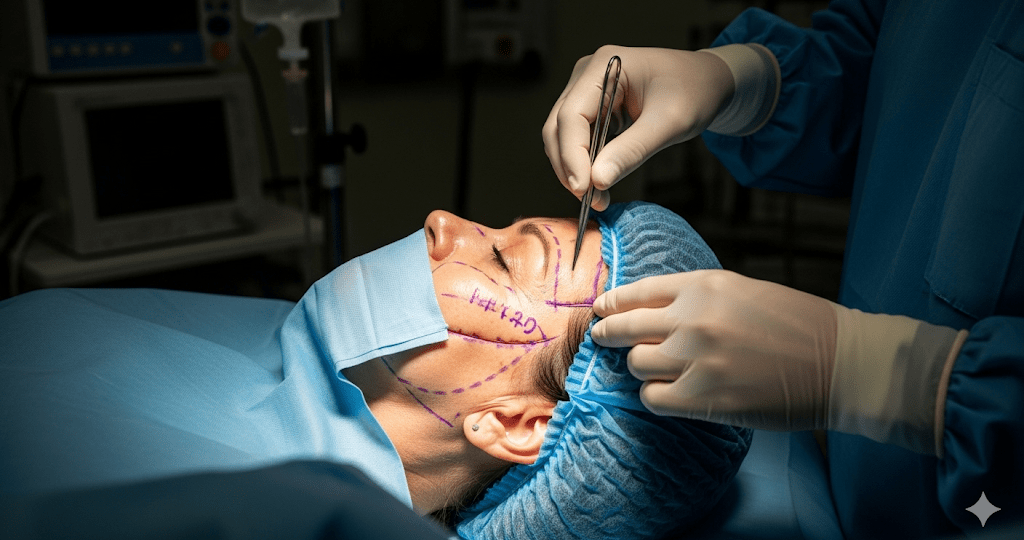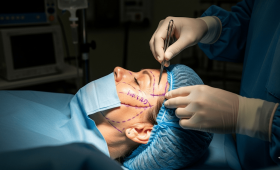What Is a Full Face Lift Surgery?
A full face lift surgery is a comprehensive aesthetic surgical procedure that aims to eliminate deep wrinkles and sagging caused by aging on the face and neck. This operation targets the middle and lower parts of the face, the jawline, and the neck to provide a younger and more rested appearance.
During the surgery, excess skin and fat tissue are removed, and the underlying muscle and connective tissue (SMAS layer) are tightened and repositioned. In this way, not only the skin but also the basic structure of the face is lifted. This procedure is generally suitable for individuals aged 45 and over who have significant signs of aging.
What Is a Mini Face Lift Surgery?
A mini face lift surgery is a less invasive procedure that is applied to a more limited area compared to a full face lift. It generally aims to correct mild to moderate sagging in the jawline and lower cheek area. In this operation, performed with shorter incisions, the skin and underlying tissue (SMAS) are tightened in a less comprehensive manner. This procedure is ideal for younger candidates, typically between the ages of 35 and 45, who are just beginning to show signs of aging on their face. The surgery time and recovery period are shorter than a full face lift.
What Are the Key Differences Between the Two Surgeries?
The main differences between a full face lift and a mini face lift are the scope of the area they are applied to, the length of the incisions, the recovery process, and the longevity of the results.
A full face lift works on a wide area including the neck, jaw, and mid-face, while a mini face lift focuses only on the lower face area. The incisions in a full face lift are wider and made in less visible places (in front of and behind the ear, and in the hairline), whereas in a mini face lift, they are shorter and generally remain in the area in front of the ear. This allows for a faster recovery from a mini face lift.
Which Surgery Is the Right Candidate for Me?
You need to consult with a plastic surgeon to determine which surgery is right for you. Generally, a full face lift is a more effective solution for individuals with deep facial wrinkles, sagging in the neck area, and a significant loss of jawline definition.
On the other hand, a mini face lift may be sufficient for younger candidates with mild sagging in their cheeks and jawline but no significant problems in their neck area. The surgeon will evaluate your facial structure and expectations to offer you the most suitable option.
How Long Is the Post-Surgery Recovery Process?
The recovery process for a full face lift surgery is longer than for a mini face lift. Generally, significant swelling and bruising are seen for the first few days. Patients can partially return to their social lives within a week, but full recovery and seeing the final results may take several months. For a mini face lift, the recovery process is faster. Most patients can return to their normal daily activities within a few days, but full recovery may still take a few weeks. Following the patient’s instructions in both operations will speed up recovery.
Is Swelling and Bruising Normal After Surgery?
Yes, swelling and bruising after surgery are normal and expected in both operations. Since a full face lift is applied to a wider area, swelling and bruising can be more pronounced. These symptoms reach their peak within the first 48 hours and then begin to gradually decrease. In a mini face lift, these symptoms are milder and disappear in a shorter time. Applying cold compresses and keeping the head elevated after surgery helps reduce swelling and bruising.
How Long Do the Results of the Surgery Last?
The results of a full face lift operation are more permanent than a mini face lift. The effect of a full face lift generally lasts for about 10-15 years. This period may vary depending on genetic factors, lifestyle, and skincare. The effect of a mini face lift generally lasts for about 5-10 years. Neither operation stops the aging process, but they significantly reverse the effects of years on the face.
What Is the Post-Surgery Pain Level Like?
The pain level in both surgeries is minimal and can usually be easily controlled with painkillers. Since a full face lift is a more comprehensive procedure, the feeling of pain may be slightly higher, but this usually decreases within a few days. The pain after a mini face lift is less, and patients are usually comfortable with mild painkillers. Pain management depends on your surgeon’s recommendations and the medications they prescribe.
What Is the Cost Difference Between the Two Surgeries?
A full face lift operation is a more comprehensive procedure than a mini face lift, so its cost is generally higher. Factors affecting the price include the surgeon’s experience, the quality of the hospital where the operation will be performed, the type of anesthesia used, and additional services. A mini face lift is naturally more affordable as it is a shorter and less complex operation. The exact price for both procedures will become clear after a consultation and the determined treatment plan.
Which Surgery Affects the Neck Area?
A full face lift surgery is quite effective in correcting sagging in the neck area and the “turkey wattle” appearance. During the surgery, the neck muscles are tightened and excess skin is removed. A mini face lift does not target the neck area. This procedure is designed to correct only mild sagging in the jawline and cheeks. Therefore, a full face lift is a more suitable option for patients who also want rejuvenation in the neck area.

What Anesthesia Is Used for a Full Face Lift?
A full face lift surgery is generally performed under general anesthesia. This means that the patient is completely asleep throughout the operation and feels nothing. General anesthesia allows the surgeon to work more comfortably and in detail. Given the duration and scope of the surgery, general anesthesia is preferred for the patient’s comfort and safety.
What Anesthesia Is Used for a Mini Face Lift?
A mini face lift surgery is generally performed with a combination of local anesthesia and sedation. Local anesthesia only numbs the area of the surgery, while sedation helps the patient relax and enter a state of light sleep. In this way, the patient is awake but comfortable during the operation. However, in some cases, general anesthesia may also be used with the patient’s preference or the surgeon’s decision.
What Preparations Should Be Made Before Surgery?
Before surgery, you must strictly follow your surgeon’s instructions. Generally, smoking and alcohol consumption should be stopped at least two weeks before the surgery. Blood-thinning medications and some vitamin supplements should also be discontinued with the surgeon’s advice. On the day of the surgery, you should wear comfortable clothes and not wear makeup. If you have any chronic illnesses or use regular medication, you must inform your surgeon.
What Is the Post-Surgery Care Like?
Post-surgery care is of critical importance for a successful recovery. You must follow the instructions given by your surgeon. Generally, for the first few days, you should lie with your head elevated, apply cold compresses, and avoid heavy exercise. Dressings and stitches should be checked and kept clean regularly. Protecting your skin from direct sunlight and using the ointments recommended by the surgeon are also important.
Do Scars Remain After Surgery?
As with any aesthetic operation, there is a potential for scars to remain after face lift surgeries. However, an experienced surgeon places these incisions in areas that are not visible or can be easily camouflaged, such as the hairline, in front of the ear, and behind the ear. While scars may be longer in a full face lift, they are shorter in a mini face lift. When the healing process is complete, the scars usually become very difficult to notice.
How Effective Are Non-Surgical Methods?
Non-surgical face lift methods (e.g., fillers, botox, laser, thread lifts) can be effective for people with mild signs of aging. These methods generally provide shorter-term results, such as 1-2 years, and do not offer the permanence and comprehensive effect provided by face lift operations. A full face lift or a mini face lift is a more permanent and radical solution for people with significant sagging and wrinkles.
Is There an Age Difference Between the Two Surgeries?
Yes, there is usually an age difference between the two surgeries. A mini face lift operation generally appeals to younger patients in the 35-45 age range. At these ages, facial sagging is usually mild, and a less comprehensive intervention is sufficient. A full face lift is generally suitable for individuals aged 45 and over who have significant signs of aging and skin laxity.
How Long Does the Surgery Take?
A full face lift surgery generally takes 3 to 5 hours, depending on the scope of the operation. This time may be extended if the surgery is combined with additional procedures such as nose or eyelid aesthetics. A mini face lift is completed in a shorter time, usually within 1.5 to 2.5 hours. The duration of the surgery may vary depending on the surgeon’s experience and the complexity of the planned procedure.
Which Areas Are Targeted by the Surgery?
A full face lift surgery targets the middle and lower parts of the face, the jawline, and the neck area. It lifts sagging cheeks, defines the jawline, and corrects wrinkles on the neck. A mini face lift focuses on a more limited area, usually the jawline and the lower parts of the cheeks with mild sagging. This procedure is not effective for wrinkles on the upper part of the face or sagging on the neck.
When Does Full Recovery Occur?
The full recovery process for a full face lift surgery is longer. While there is significant bruising and swelling in the first week, these symptoms decrease significantly within 2-3 weeks. It should be noted that it can take 6 months to 1 year for the final results and the skin to fully settle. In a mini face lift, these processes are faster. Most patients can fully return to their social lives within a few weeks, but seeing the full recovery and final results may still take a few months.
Why Are Face Lift Operations Performed?
Face lift operations are performed to eliminate sagging, deep wrinkles, and skin laxity that occur on the face and neck with the aging process. These operations aim to give individuals a younger, more rested, and more vibrant appearance, thereby increasing their self-confidence. A face lift is an effective solution for permanently correcting aging signs caused by factors such as genetics, sun damage, and lifestyle.
Does the Facial Expression Change After Surgery?
A face lift surgery performed by an experienced surgeon does not cause any negative changes in facial expression. The purpose of the operation is to give the face a younger and fresher appearance, preserving natural facial features and expressions. After a successful operation, patients usually have a more rested and vibrant expression.
What Are the Risks of the Two Operations?
As with any surgical procedure, both full and mini face lift operations have potential risks. The most common risks include infection, bleeding, nerve damage (which can cause temporary or permanent numbness or muscle weakness), complications related to anesthesia, and scarring problems. Since a full face lift is a more comprehensive procedure, its risks may be slightly higher. However, these risks are minimized when the operation is performed by an experienced surgeon in a good hospital environment.
What Are the Advantages of the Surgery?
A full face lift provides a more comprehensive rejuvenation effect. It corrects all signs of aging in the lower and middle parts of the face, as well as on the neck, at the same time. A mini face lift, on the other hand, is less invasive, has a shorter recovery time, and is less risky. The biggest advantage of both operations is that they offer much more permanent and effective results compared to non-surgical methods.
Can the Two Operations Be Applied Together?
A mini face lift and a full face lift are operations of different scopes, so they are not performed together. However, to address problems in different areas of the face, face lift surgeries can be combined with other aesthetic surgical procedures such as eyelid aesthetics, eyebrow lifts, or fat injections at the same time. This allows the patient to solve multiple problems with a single surgery and shortens the overall recovery process.
What Are the Post-Surgery Check-ups Like?
Post-surgery check-ups are important for monitoring the healing process and evaluating the final results. You may need to see your surgeon within the first few days to have the dressings and stitches checked. In the following weeks and months, regular check-ups are planned to observe the reduction of swelling and bruising, the healing of scars, and the settling of facial features.

Does a Full Face Lift Vary According to Skin Type?
Yes, skin type is an important factor in planning a full face lift operation. The results of the surgery may be better in individuals with elastic and good-quality skin. Very thin or very thick skin types can affect the recovery process or the final result. The surgeon will determine the most suitable techniques and approaches for your skin type.
How Much Does a Mini Face Lift Rejuvenate?
A mini face lift can make patients look 5-10 years younger, especially by correcting mild sagging in the jawline and cheeks. This procedure does not provide as comprehensive an effect as a full face lift, but it is an effective solution for those who want to achieve a younger and fresher appearance.
Which Surgery Should I Research More?
It is important to do extensive research for both surgeries. Since a full face lift is a more radical and permanent procedure, you should get more detailed information about the choice of surgeon, the hospital where the surgery will be performed, and the recovery process. Although a mini face lift is less risky, choosing a good surgeon is still of critical importance for the results to meet your expectations.
Does a Face Lift Surgery Affect Body Weight?
No, face lift surgeries do not directly affect body weight as they are procedures performed on the face and neck area. Adopting a healthy lifestyle and maintaining your ideal weight after the surgery are important for the long-term permanence of the operation’s results.
Should I Get a Facial Massage After Surgery?
You should not get a facial massage after surgery without your surgeon’s recommendation. In the first stages of the recovery process, massage can damage sensitive tissues or increase swelling. Your surgeon may recommend light massages or lymphatic drainage techniques at a certain stage of the recovery process to help tissue healing.
When Can I Start Exercising After Surgery?
The time to start exercising after surgery depends on the scope of the operation. After a full face lift, it is recommended to avoid heavy sports and exercise for at least 4-6 weeks. Activities like light walking can usually be started after a few weeks. After a mini face lift, this period is shorter, and light exercise can usually be started after 2-3 weeks.
Up to What Age Can a Full Face Lift Be Done?
There is no definitive upper age limit for a full face lift surgery. What is important is that the person’s general health condition is suitable for the operation. The surgeon will decide whether you are a suitable candidate for the surgery by evaluating your skin quality, bone structure, and health condition rather than your age.
How Do the Scars Look After Surgery?
The appearance of scars after surgery changes over time. Initially, the scars are red and noticeable, but over time, they begin to fade and turn white. Within a year, the scars usually become very difficult to notice. It is important to use the ointments recommended by your surgeon and protect yourself from the sun for better healing of the scars.
Which Surgery Causes More Bruising?
A full face lift surgery can cause more bruising and swelling than a mini face lift as it involves a wider area. Bruises generally reach their peak within the first 2-3 days and then gradually disappear. Individual differences and the body’s reaction can affect the duration and intensity of the bruising.


